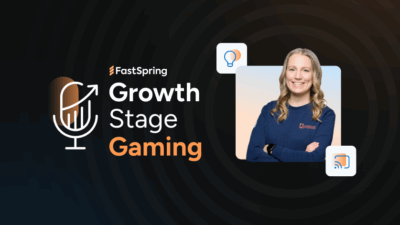While we’ve been shopping for items like clothes or shoes online for years, another trend is now emerging—business-to-business (B2B) ecommerce.
It’s easy to think of online sales as a marketplace where we buy items for ourselves, but more and more B2B and SaaS sales are now happening online. As of 2019, B2B ecommerce sales globally have surpassed $12 trillion in revenue.
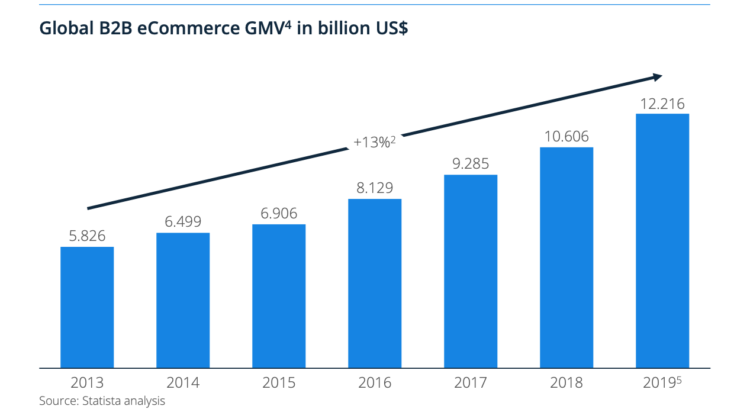
According to Statista, B2B sales are now 6X larger than the business-to-consumer (B2C) market. A 2018 survey found that nearly half of companies make 50–74% of all their corporate purchases online.
To make the most of these opportunities, B2B vendors need to realize that simply implementing ecommerce into their business won’t guarantee a chunk of the pie. It comes down to having an online presence, understanding buyers’ needs, and, most importantly—a platform that can handle transactions.
In this piece, we’re going to explore
- What is B2B Ecommerce?
- Why B2B Ecommerce is on the rise
- How businesses can take advantage of the growth around B2B Ecommerce
- Is your business ready for the Future of B2B eCommerce?
Let’s get selling!
What Is B2B Ecommerce?
B2B Ecommerce is where a transaction between two businesses takes place online. If a product or service is being sold online—regardless if the sale itself happens through a sales-rep assisted process, online shop, or platform—it’s considered B2B ecommerce.
To visualize what B2B ecommerce covers, we’re talking about:
- Distribution selling: if a business is selling to another large store or chain retailer
- Wholesale selling: if a business is selling to another in bulk
- Organizational selling: if a business is selling to organizations like nonprofits or schools
- Targeted selling: if a business is selling to other businesses that they would typically target offline
For these companies, the change to a B2B sales model means moving their customers to make their purchases online. Instead of dealing with a sales rep, B2B buyers will interact with a company’s website and purchase products and services using an online marketplace and transaction platform.
In some ways, the move from B2B sales happening offline to online mirrors other trends we see in the B2C market. Rather than selling offline, businesses are coming to terms with the fact that distributing products and services from a specialized ecommerce platform makes the process a lot easier.
It’s easy to see why about 23% of companies now do more than 75% of all their purchases online—it’s easier and more convenient. Streamlining how other businesses buy products, software, and services free up employees within a business to tackle different tasks when they’ve historically been tied up in lengthy sales meetings and demos.
Paul Miller, founder of Chicago e-commerce consulting firm PMA Digital Solutions, believes Ecommerce is taking hold of the B2B market because companies of all sizes see it as a better and more efficient way to do business.
“We’re seeing a shift away from more traditional procurement methods such as phone, fax, and paper catalogs by corporate buyers that prefer the ease and convenience of e-commerce,” he says.
This was the exact problem that BizNet hit when they realized their manual B2B sales strategy was no longer working for them—or their customers.
The software company, which started in 1996, positioned itself to B2B buyers to leverage Microsoft Excel and use it as a self-service analytics and reporting service. In its aim to make Excel reporting fun, BizNet offered businesses a way to cut out the complexity of report building so they could focus on using their data to find ways to make companies work better instead.
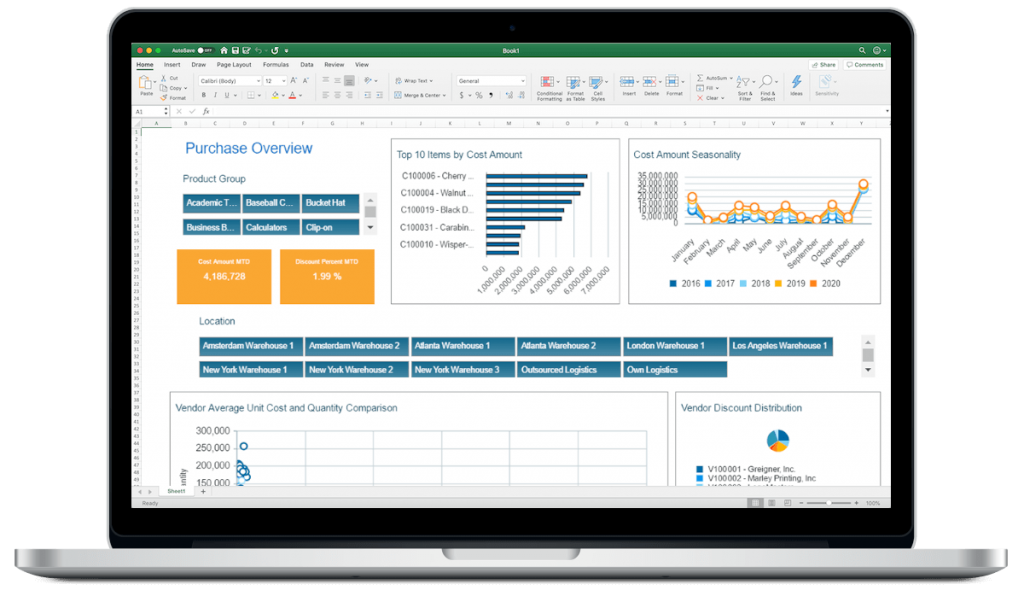
There was one problem—the process of buying BizNet’s software wasn’t exactly straightforward.
Although customers could purchase BizNet’s software on its website, the orders were processed manually. This meant that there was a chance of human error by BizNet’s staff, and their customers also had to wait over 24 hours to receive access to their product. It wasn’t ideal for the business or its customers.
“It was just very inefficient and not terribly profitable,” says BizNet’s Director of Customer Experience and Operations, Brian Nicholson
“When our customers ordered something, they wanted it right away.”
BizNet realized the solution to its problem was automating the buying process. So, they invested in FastSpring, a specialized ecommerce platform to take care of order fulfillment and processing transactions. Now, when a customer buys a piece of software from BizNet, they can pay directly through the website, and FastSpring automatically fulfills the order. This means the customer has access to the software immediately, but it also frees up BizNet’s staff to focus on other aspects of the business.
Why B2B Ecommerce Is on the Rise
B2B ecommerce is on the rise not only because it’s more convenient but also because of generational changes.
Those in charge of making B2B buying decisions aren’t stuck in a mindset of doing business over fax or phone. Instead, studies show that 73% of today’s B2B buyers are millennials who are involved in the decision making process at a company. The research also indicates that a third of these millennials are the sole decision-maker during a B2B transaction, making them a vital element of the rise of ecommerce:
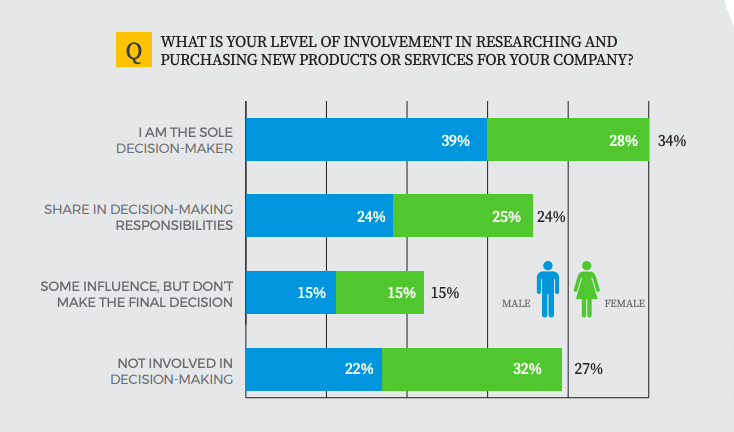
Because of this, it has been easier for B2B ecommerce to grow, and it’s one of the main reasons why the global ecommerce market is expected to be worth over $24 trillion by 2025. Of course, there are other reasons why B2B ecommerce is rising in popularity like:
🌎 More companies (and countries) now have accessible internet
💻 Tech advances like SaaS and cloud-based ecommerce platforms make it easier to buy
📦 More choice and competition around shipping and payment options
The changes mean a CEO can make a purchase using their mobile phone while waiting in an airport, which was impossible to do even a decade ago. Of course, this also comes down to businesses becoming more tech-savvy. One study by Google found a large chunk of B2B buyers have grown up in a world of advanced tech, which they’ve always used to make their purchasing decisions.
All of this means one thing—if businesses do not move online, they risk losing an audience with more buying power and more tech-savvy than ever before.
How Businesses Can Take Advantage of the Growth Around B2B Ecommerce
It’s clear that to succeed in the B2B market, making your product available online is a winning strategy.
However, exceeding in the online B2B market takes more than launching a website and waiting for orders to roll in. Businesses need to invest in a strategy that means their customers will be able to find them, they have a presence online, and orders will be fulfilled quickly.
Here are four ways you can make sure your transition into the B2B ecommerce market is a smooth one.
Tip #1: Make sure your customers can find you online by investing in SEO
You can have the most beautiful website in the world but, unless your customers can find you, it won’t help your bottom line.
That’s why the first step of your B2B ecommerce journey is making sure your customers can find you. As businesses discover websites using search results, it’s essential to have your website equipped for SEO (search engine optimization). A basic working SEO strategy for your ecommerce site should include:
- Targeted keywords on your blog posts, website, and landing pages
- Making sure your site is responsive on both desktop and mobile devices
- Shareable content that you can use to boost your profile on social media
- Social proof such as testimonials and customer stories
Along with optimizing your site for SEO, it also needs to be engaging once potential customers land. You need to make sure that the copy and call-to-actions on your site target your customer personas and gives them compelling and accurate information about your products. After all, the website is supposed to replace a sales rep, so make sure it provides visitors all the information they need to make a purchasing decision and then helps drive them to take the desired action.
Your site should also:
📈 Collect data: So you know what keywords are helping your site rank, and which ones you need to change. If you don’t collect data on how your site performs, it’s hard to know what parts of your SEO strategy is working
💡Highlight product features: So your target audience knows they are in the right place. Put them front and center on your homepage, so it’s immediately apparent to customers that they’re in the right place
A big part of making your site as optimized as possible is about investing in good content.
Tip #2: Invest in great content
Just because you move your buying journey online doesn’t mean that the hard work of landing sales goes out the door.
All of the work that you need to put into closing a B2B transaction still applies. You need to show potential customers that your product or service will add value to their business, and the best way to do that is by investing in content assets. Whether through blog posts or case studies that showcase success stories other businesses have had with your company, content can answer customer questions and instill confidence in your product without getting a sales rep involved.
The buying journey for B2B sales is still longer than a B2C transaction. Take a look at this journey map by Forrester:
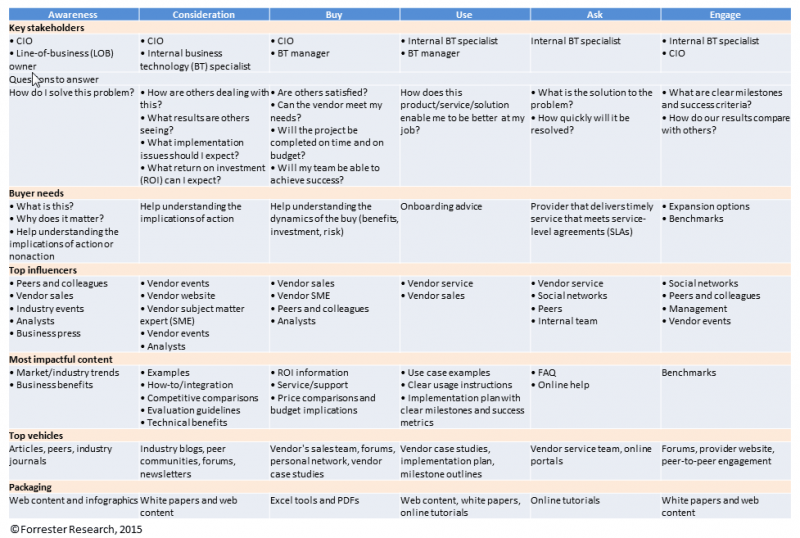
As you can see, when a business decides to buy a product, it’s a little more complicated than if we’re visiting the corner shop to pick up some milk. So your site needs to answer questions about product specifications, onboarding, integrations, and how successful it’s been for similar businesses.
There are lots of ways you can get your message across. You might decide to invest in white papers and case studies, or go social by targeting customers through LinkedIn and webinars. No matter what route you use, remember one important factor: you should have content to cover each stage of your customer’s buying journey. You might entice them to look at your product by offering up a free webinar, but to convince them to buy, you’ll need case studies showing how successful your product has been for other businesses.
Once you know what content you need, it’s time to make sure your website moves people along their buying journey.
Tip #3: Make your website user-friendly and easy to navigate
You can have the best content and SEO strategy in the world, but if you don’t make it easy for visitors to buy your products, all that effort will be wasted.
Focus on how much friction your customers experience on your website. If they’re looking for a specific product or service, you should either have a search function or a section on your site dedicated to each item you’re selling. As B2B sales are more complex than buying items like clothing, you must also have a detailed description and breakdown of each product.
Ahrefs is an excellent example of this. Not only do they break down each product they offer with its own section:
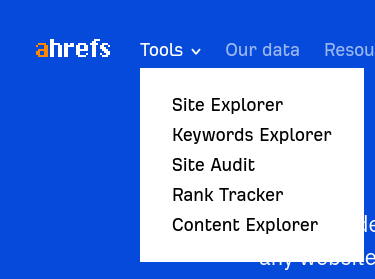
But each tool is also given a detailed breakdown of what it is and what value it can add to a potential buyer’s business:
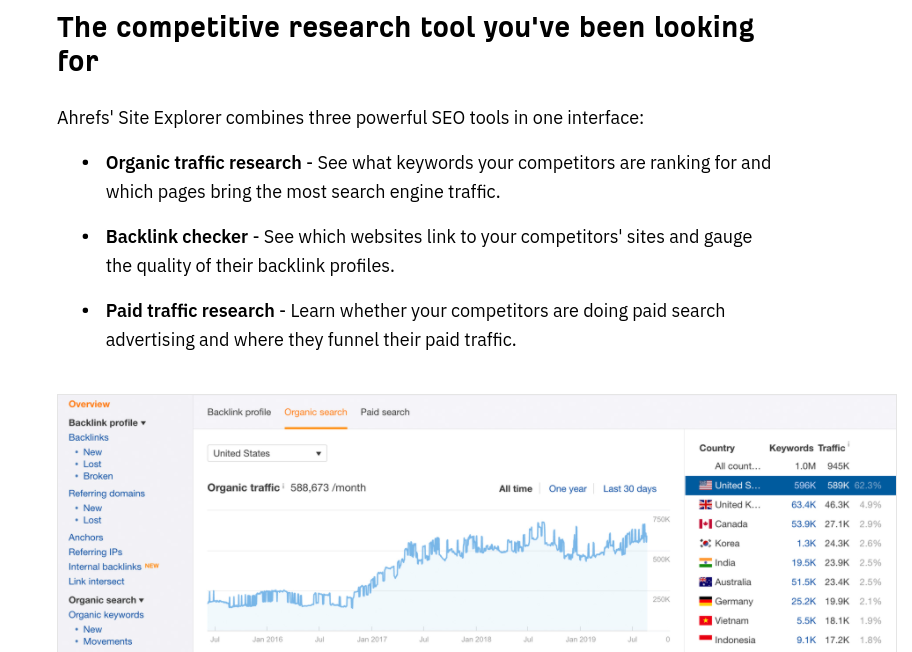
In the past, these features and breakdown would have been explained to a potential customer by a dedicated sales representative. Now, businesses can explore Ahrefs website whenever they like to see if the product will be a good fit for their business.
However, it’s essential not to overlook arguably the most crucial part of the B2B buying process—the checkout. If you make your checkout process too tedious or add unnecessary steps, you risk adding friction to the buying process and even losing potential customers.
Again, Ahrefs avoids this by only asking customers for necessary details when they buy a product. Using FastSpring, Ahrefs processes orders straight from its pricing page in the customer’s preferred currency, either using card details, PayPal or AmazonPay:
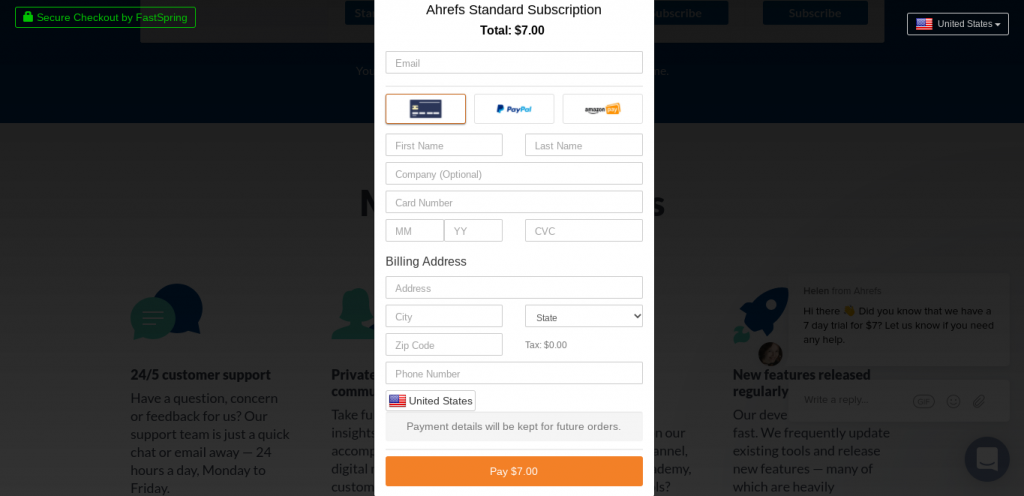
Not only is the transaction processed automatically, but the customer also gets immediate access to Ahrefs. With the right ecommerce setup, landing B2B deals has never been simpler.
Tip #4: Simplify the steps in your customer’s buying journey
Our last tip to making a successful move to B2B ecommerce? Keep it simple.
Even though B2B sales need a certain amount of information and content to help buyers make an informed decision, don’t go overboard. Otherwise, you risk putting your potential customers into what Harvard Business Review (HBR) calls “analysis paralysis.” HBR suggests that, just as more choice isn’t always a good thing for individual consumers, the same is true for B2B purchases.
“No matter the choice, some stakeholders will always find aspects of an alternative more appealing,” HBR says.
“In addition to slowing the purchase process, an excess of options leads to post-purchase anxiety: “Did we do the right thing? Would another choice have been better?”
“Our research shows that such second-guessing occurs in more than 40% of completed B2B purchases.”
To avoid this, B2B sellers can move to a “prescriptive” approach to selling. Instead of answering every question a customer has, B2B sellers can use a prescriptive approach to selling and give their customers a clear, rational product choice that clearly explains the purchase process. By doing so, it not only makes it easier for customers to come to a purchasing decision but it also minimizes post-purchase regret:
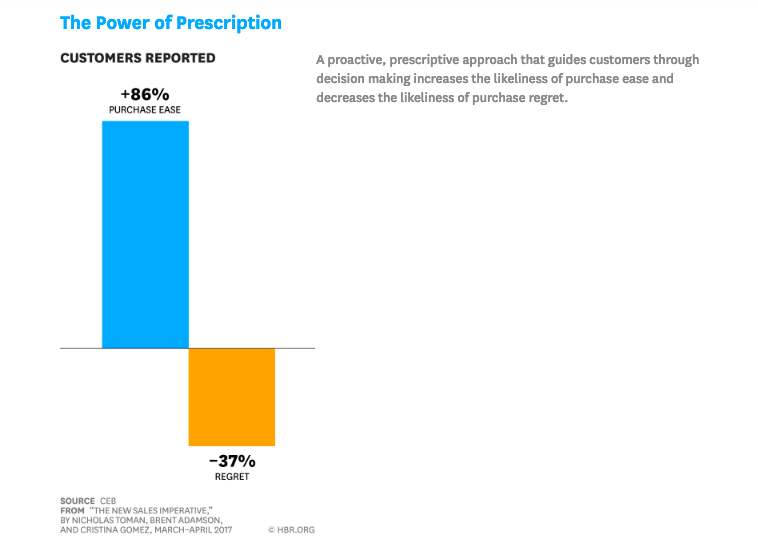
There are a couple of boxes your B2B ecommerce site needs to tick to move to a prescriptive approach to selling products and services. First, take a look at any challenges customers might face when purchasing products on your site:
- Did they have any difficulty at any stage in the process? If so, at what stage?
- Did they have enough information to help them make a faster buying decision?
Problems and lack of information vary considerably depending on where a customer is on their buying journey:
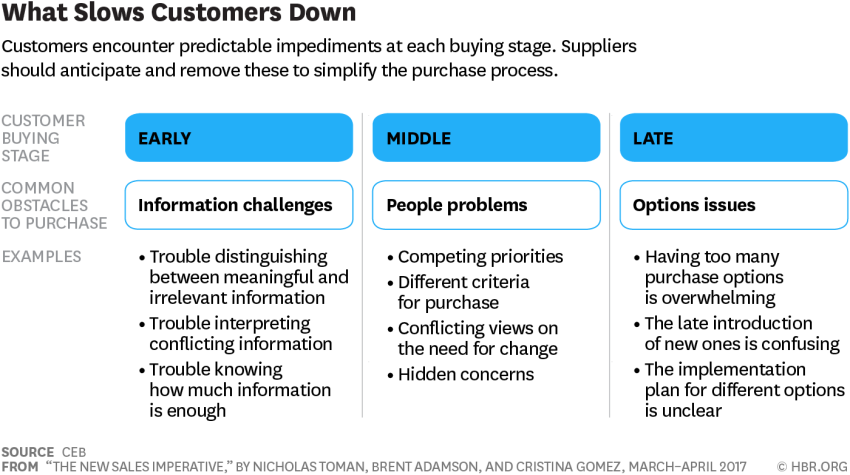
Next, check your checkout.
- Is it easy for the customer to make a one-off/subscription purchase?
- If a customer abandons their purchase, do you have a strategy to follow up with them?
- Once a purchase is made, will payment be taken automatically, and the product be available to the customer immediately?
The last part of the buying journey—the checkout—relies on having an ecommerce platform that works for your business.
Is Your Business Ready for the Future of B2B Ecommerce?
The success of moving to a B2B ecommerce strategy relies on investing in a platform that makes online transactions automatic and easy.
As you’ve seen from BizNet’s attempt at manually fulfilling orders, without the help of ecommerce tech, online transactions are difficult for humans to handle. At its core, your ecommerce platform should:
- Offer a checkout platform that easily integrates with your existing website
- Give you a secure way to process payments
- Be mobile-friendly and work across a range of devices
- Offer customers several different payment options
- Store data and analytics to help you improve your site’s performance
If you are making a move to B2B ecommerce, choosing a suitable vendor can be daunting—especially with so many options to consider. Ultimately, it’s up to your business to choose the right platform that suits your needs. Not only should you look to pick a platform that suits your business now, but one that can handle your operations if your company starts to scale.
A platform like FastSpring can take your business a step further. It has a network of 10,000+ affiliates that can increase awareness around your products, while also:
🚀 Boosting your sales through cross-sells and upsells on ordering pages
📈 Encouraging customers to visit your site using tools that track SEO, email marketing, and PPC campaign analytics
👨👧👦 Increasing customer loyalty by taking care of problems and questions through a dedicated customer service team
Ready to see how a full-service ecommerce platform can get your business prepared for the rise in B2B ecommerce? Click here to speak with one of our platform experts and learn how outsourcing your B2B ecommerce needs can boost your sales revenue today!






